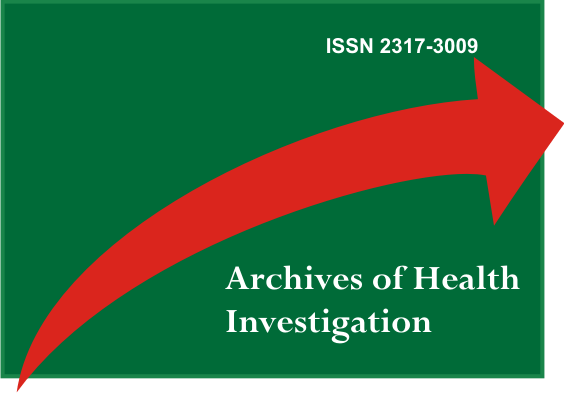Atividade anti-Candida tropicalis dos enantiômeros (R)-(+)- & (S)-(-)-citronelal em associação com nistatina
DOI:
https://doi.org/10.21270/archi.v7i1.2278Resumo
A candidíase vulvovaginal (CVV) é uma infecção ginecológica desafiadora com as quais muitas mulheres e médicos lutam. O agente etiológico é principalmente a C. albicans. No entanto, outras espécies não-albicans, sobretudo a C. tropicalis pode estar envolvida. O objetivo desse estudo foi investigar a atividade antifúngica dos enantiômeros (R)-(+)- e (S)-(-)-citronelal e os efeitos da combinação destes com a nistatina contra cepas de C. tropicalis. Portanto, foram aplicados protocolos experimentais para avaliar de maneira qualitativa e quantitativa a capacidade fungicida dos enantiômeros, como a concentração inibitória mínima (CIM) e a concentração fungicida mínima (CFM) em meio líquido RPMI-1640. Além disso, os ensaios de associação dos fitoconstituintes com a nistatina foram realizados através da técnica de difusão em meio sólido, agar sabouraud dextrose (ASD). Os compostos (R)-(+)- e (S)-(-)-citronelal mostraram-se fungicida frente às cepas testadas, tendo em vista que ambas as moléculas apresentaram a relação CFM50/CIM50entre 1 e 2. Além de efeitos sinérgicos significativos com a nistatina, contra as cepas LM 255 e LM 665. Por tanto, esses fitoconstituintes podem ser promissores protótipos farmacológicos antifúngicos no futuro.Descritores: Candidíase Vulvovaginal; Antifúngicos; Candida tropicalis; Nistatina.
Downloads
Referências
Watson C, Pirotta M. Recurrent vulvovaginal candidiasis: current management. Aust Fam Physician. 2011; 40(3):149-51.
Sobel JD, Faro S, Force RW, Foxman B, Ledger WJ, Nyirjesy PR et al. Vulvovaginal candidiasis: epidemiologic, diagnostic, and therapeutic considerations. Am J Obstet Gynecol. 1998; 178(2):203-11.
Foxman B, Marsh JV, Gillespie B, Sobel JD. Frequency and response to vaginal symptoms among white and African American women: results of a random digit dialing survey. J Womens Health. 1998; 7(9):1167-74.
Sobel JD. Vulvovaginal candidosis. Lancet. 2007; 369(9577): 1961-71.
Horowitz BJ. Mycotic vulvovaginitis: a broad overview. Am J Obstet Gynecol. 1991; 165(4 Pt 2):1188-92.
Monga A, Dobb S. Gynaecology. 19. ed. London: Hodder Arnold; 2011.
Lindner JG, Plantema FH, Hoogkamp-Korstanje JA. Quantitative studies of the vaginal flora of healthy women and of obstetric and gynaecological patients. J Med Microbiol. 1978; 11(3):233-41.
Sobel JD. Recurrent vulvovaginal candidiasis: a prospective study of the efficacy of maintenance ketoconazole therapy. N Engl J Med. 1986; 315(23):1455-8.
Pappas PG, Rex JH, Sobel JD, Filler SG, Dismukes WE, Walsh TJ et al. Guidelines for treatment of candidiasis. Clin Infect Dis. 2004; 38(2):161-89.
Lorenzi V, Muselli A, Bernardini A, Berti L, Pagès JM, Amaral L et al. Geraniol restores antibiotic activities against multidrug-resistant isolates from Gram Negative species. Antimicrob Agents Chemother. 2009; 53(5):2209-11.
Avoseh O, Oyedeji O, Rungqu P, Nkeh-Chungag B, Oyedeji A. Cymbopogon Species; Ethonopharmacology, Phytochemistry and the Pharmacological Importance. Molecules. 2015; 20(5):7438-53.
Wagner H. Multitarget-therapy, the future of treatment for more than just functional dyspepsia. Phytomedicine. 2006; 13(1): 122-9.
Nascimento PFC, Nascimento AC, Rodrigues CS, Antoniolli AR, Santos PO, Barbosa Júnior AM, et al. Atividade antimicrobiana dos óleos essenciais: uma abordagem multifatorial dos métodos. Rev Bras Farmacogn. 2007; 17(1):108-13.
Pereira Fde O, Mendes JM, Lima IO, Mota KSL, Oliveira WA, Lima Ede O. Antifungal activity of geraniol and citronellol, two monoterpenes alcohols, against Trichophyton rubrum involves inhibition of ergosterol biosynthesis. Pharm Biol. 2014; 53(1):1-7.
Reference method for broth dilution antifungal susceptibility testing of yeasts; Aproved Standard. 3.ed. CLSI-document M27-A3, Clinical and Laboratory Standards Institute, Wayne, PA, USA, 2008.
Ostrosky EA, Mizumoto MK, Lima MEL, Kaneko TM, Nishikawa SO, Freitas BR. Métodos para avaliação da atividade antimicrobiana de determinação de concentração mínima inibitória (CMI) de plantas medicinais. Rev Bras Farmacog. 2008; 18(1):301-7.
Hadacek F, Greger H. Testing of antifungal natural products: methodologies, comparability of results and assay coices. Phytochem Analysis. 2000; 11(1):137-47.
Nattinal committee for clinical laboratory standards (NCCLS). Reference method for broth dilution antifungal susceptibility testing of yeasts. Villanova 2002; 17:M27-A2.
Morales G, Paredes A, Sierra P, Loyola LA. Antimicrobial activity of three Baccharis species used in the traditional medicine of Northern Chile. Molecules. 2008; 13(1):790-4.
Cuenca-Estrella M. Combinations of antifungal agents in therapy-what value are they? J Antimicrob Chemother. 2004; 54(1):854-69.
Oliveira RAG, Lima EO, Viera WL, Freire KRL, Trajano VN, Lima IO et al. Estudo da interferência de óleos essenciais sobre a atividade de alguns antibióticos usados na clínica. Rev Bras Farmacogn. 2006; 16(1):77-82.
Morales G, Paredes A, Sierra P, Loyola LA. Antimicrobial activity of three Baccharis species used in the traditional medicine of Northern Chile. Molecules. 2008; 13(4):790-4.
Zore GB, Thakre AD, Jadhav S, Karuppayil SM. Terpenoids inhibit Candida albicans growth by affecting membrane integrity and arrest of cell cycle. Phytomedicine. 2001; 18(13):1181-90.
Pereira Carneiro JN, Albuquerque RS, Figueiredo LN, Targino MAJ, Vieira de Brito DI, Rolón M et al. Avaliação da atividade tripanocida, leishmanicida e citotóxica do geraniol e citronelal. Cad Cult Ciênc. 2015; 13(2):29-36.
Alczuk SDES, Bonfim-Mendonça PDES, Rocha-Brischiliari SC, Shinobu-Mesquita CS, Martins HP, Gimenese F et al. Effect of highly active antiretroviral therapy on vaginal candida spp. isolation in hiv-infected compared to hiv-uninfected women.Rev Inst Med Trop São Paulo. 2015; 57(2):169-74.
Khan A, Ahmad A, Akhtar F, Yousuf S, Xess I, Khan LA et al. Ocimum sanctum essential oil and its active principles exert their antifungal activity by disrupting ergosterol biosynthesis and membrane integrity. Res Microbiol. 2010; 161(10):816-23.
Keniya MV, Fleischer E, Klinger R, Cannon RD, Monk BC. Inhibitors of the Candida albicans major facilitator superfamily transporter Mdr1p responsible for fluconazole resistance. PLoS One. 2015; 10(5):1-16.
Ruiz-Camps I, Cuenca-Estrella M. Antifúngicos para uso sistémico. Enferm Infecc Microbiol Clin. 2009; 27(6):353-62.
Hafidh RR, Abdulamir AS, Vern LS, Abu Bakar F, Jahanshiri F, Sekawi Z. Inhibition of growth of highly resistant bacterial and fungal pathogens by a natural product. Open Microbiol J. 2011; 5:96-106.
Shin S, Lim S. Antifungal effects of herbal essential oils alone and in combination with ketoconazole against Trichophyton spp. J Appl Microbiol. 2004; 97(1):1289-96.
Karpanen TJ, Worthington T, Hendry ER, Conway BR, Lambert PA. Antimicrobial efficacy of chlorhexidine digluconate alone and in combination with eucalyptus oil, tea tree oil and thymol against planktonic and biofilm cultures of Staphylococcus epidermidis. J Antimicrob Chemother. 2008; 62(5):1031-6.


